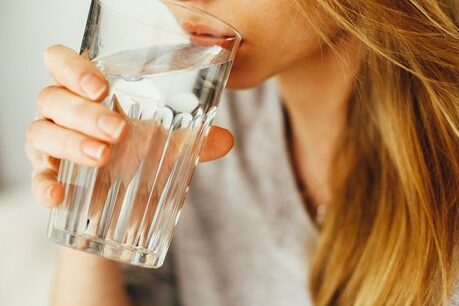The summer months are upon us, and so is the danger of dehydration. Water is essential to the functionality of life. Unfortunately, most individuals intake less H2O than they need to stay hydrated. The adult human body is composed of approximately 60 percent water that vitalizes organs, tissue, muscles and even bones. It also regulates body temperature, supplies nutrition and oxygen to cells, metabolizes carbohydrates and proteins for better absorption, and filters bodily waste.
Although, maintaining hydration is often easier said than done. The human body constantly loses water through perspiration, urination, defecation and breathing, which occurs when sedentary or active. Remembering to drink enough water throughout the day can be difficult, but making it a habit can directly improve your health and overall well-being. So, where should you begin?
1. Drinking the water your body needs
Public health guidelines recommended by the U.S. National Academies of Sciences, Engineering and Medicine suggest that men consume about 15.5 cups (3.7 liters) and women consume 11.5 cups (2.7 liters) of fluids per day. However, every person’s body has its own unique requirements for water intake and hydration levels. It depends on age, sex, weight, height, physical activity, health conditions and region. With so many factors, how can you determine how much water your body needs? One way to intake the adequate amount is by dividing your body weight in half and utilizing that number as ounces you should drink in a day. For example, if you weigh 140lbs you should consume 70 ounces of water in a day. Another way to determine the individualized volume of water your body needs is with the help of a hydration calculator. This tool takes nearly every factor into account and derives a more accurate assessment of your physical requirements.
Once you know how much water you need, it’s time to set a routine in place. The first thing to consider is how you can best hold yourself accountable for consuming water on a frequent basis. Mobile applications can remediate this stress by enabling you to set reminders throughout the day to reduce the risk of dehydration. Additionally, some hydration water bottles record data as you drink and compile that information within a synchronized application for you to track. If mobile apps aren’t your thing, No problem. You can track your own water consumption by marking a large water bottle with indicating lines that list the ounces and time of day.
2. Don’t just quench your thirst, satisfy it!
It’s understandable to get tired of drinking water when we need to consume over half a gallon a day. Adding a little flavor to your fluids may be just the right motivator.
Slice it up and throw it in! Fresh fruit such as strawberries, cucumbers, lemons, oranges, and limes create refreshing flavors and provide essential vitamins with every sip you take. If you’re looking for a metabolism boost, try adding ginger or celery to invigorate your body.
Infuse and relax. Herbal tea pouches cater to your feelings, whether you’re sleepy, ill, stressed or simply craving a mood booster. In addition, they yield several health benefits such as increasing metabolism, supplying essential vitamins and nutrients, and improving physiological functions.
3. Obtain fluids from food
Many fruits and vegetables are not only healthy but also hydrating. Celery, cucumber, watermelon, tomato, zucchini, strawberries, iceberg lettuce, spinach, cabbage, cantaloupe, radishes, grapefruit, bell peppers, cauliflower and broccoli contain above 90% of water. Others may be less in volume but not in value, such as grapes, blueberries, raspberries, cranberries, oranges, apricots, peaches and pineapple, which contain above 80% of water.
4. Prepare for activities
Any type of physical activity, regardless of how strenuous, expels water from your body. Before exercising, try to begin fully hydrated. If you are dehydrated, you may experience a rapid heart rate, low blood pressure, headaches, muscle cramps, constipation, darkened or decreased urination, dry mouth, disorientation, sunken eyes or delirium. Know the signs and be proactive.
When you lose bodily fluids, you’re losing essential minerals. Electrolytes interact with water to conduct electricity, which assists in preventing fluid imbalances, regulating blood pressure, delivering oxygen, contracting muscles and maintaining the acidity (pH) of your blood. After you rehydrate with water, consider these options to replenish electrolytes: coconut water, cactus water or nectar, bone broth, electrolyte supplements (powder or liquid), and foods that contain magnesium, potassium, calcium or sodium.
5. Reduce risks in the heat
Humidity and heat are hydration’s worst enemies. Excessive exposure to the sun can cause heat cramps, heat syncope (dizziness or fainting), heat exhaustion or heat stroke. Before embarking on an outdoor journey in high temperatures, take precautions for your safety. Take an abundant water supply, drink frequently, wear loose clothing and broad-spectrum sunscreen, shield your skin with hats or umbrellas, and restrict vigorous physical activity.
When it comes to health, it is vital to feed your body what it needs. The vessel we call home should be treated as one, and sometimes it’s as simple as drinking enough water and preparing before going out in the sun or embarking on a physical activity. Begin cultivating a healthy lifestyle by taking a more proactive approach with your diet and routine. Observing your physiological indicators to help recognize the signs to prevent dehydration.

